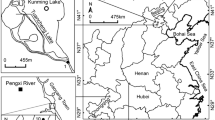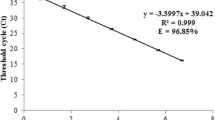Abstract
An important issue in the management of zebra mussel (Dreissena polymorpha) populations is early, rapid, and accurate detection of the planktonic larvae (veliger) of the zebra mussel. The goal of this study was to explore the feasibility of developing a molecular approach for the detection of zebra mussel larvae in diverse environments. In this study a Dreissena polymorpha-specific 18S ribosomal RNA gene targeted oligonucleotide primer (ZEB-715a) and Polymerase Chain Reaction (PCR) assay was developed and compared with cross-polarized microscopy as a means to detect zebra mussel veligers in plankton samples. The design of the zebra mussel-specific primer was facilitated by sequencing nearly the complete 18S rRNA gene from the zebra mussel and three other closely related freshwater Veneroids including the quagga mussel (D. bugensis), the dark false mussel (Mytilopsis leucophaeata), and the Asian freshwater clam (Corbicula fluminea). The specificity of the primer for the zebra mussel was empirically tested by using the primer as a direct probe in a blot hybridization format. A single veliger in a plankton sample could be detected by PCR using this approach. Veliger detection sensitivity using the PCR approach was estimated to be over 300 times more sensitive than cross-polarized light microscopy based techniques. Cross-polarized light microscopy and the PCR technique were used to identify the presence of zebra mussel larvae in plankton samples that were collected from a variety of natural and industrial water sources. Detection results (presence or absence) were generally consistent between the two methods. Although additional studies will be required before routine application of molecular based veliger detection technology is available, a long-term goal of this work is the application of molecular technology to the development of a field device for the routine detection and quantification of zebra mussel veligers.
Similar content being viewed by others
References
Alberts, B., D. Bray, J. Lewis, M. Raff, K. Roberts & J. D. Watson, 1994. Molecular Biology of the Cell. Garland Publishing, Inc., New York: 1294 pp.
Amann, R. I., W. Ludwig & K.-H. Schleifer, 1995. Phylogenetic identification and in situ detection of individual microbial cells without cultivation. Microbiol. Rev. 59: 143–169.
Andrusov, N. I., 1898. Fossile und lebende Dreissensidae Eurasiens. Trudy St. Petersburgskago Obshchestva Estestvoispytatelei 25: 1–115 + plates.
Archambault-Guezou, J., 1976. Présence de Dreissenidae euxiniques dans les dépôts à Congáries de la valláe du Rhône et sur le pourtour du bassin Méditerranéen. Implications biogéographiques. Bull. Soc. Geol. Fr. 18: 1267–1276. 43
Baldwin, B. S., M. Black, O. Sanjur, R. Gustafson, R. A. Lutz & R. C. Vrijenhoek, 1996. A diagnostic molecular marker for zebra mussels (Dreissena polymorpha) and potentially coocurring bivalves – mitochondrial COI. Mol. Mar. Bio. Technol. 5: 9–14.
Bell, J. L. & J. P. Grassle, 1998. A DNA probe for identification of larvae of the commercial surfclam (Spisula solidissima). Mol. Mar. Biol. Biotechnol. 7: 127–137.
Benson, D. A., I. Karsch-Mizrachi, D. J. Lipman, J. Ostell, B. A. Rapp & D. L. Wheeler, 2000. GenBank. Nucleic Acids Res. 28: 15–18.
Brady, T. J., J. E. VanBenschoten, J. N. Jensen, D. P. Lewis & J. Sferrazza, 1993. Sampling and enumeration of zebra mussel veligers: implications for control. J. AWWA June: 100–103.
Caraco, N. F., J. J. Cole & D. L. Strayer, 1994. An invasive species alters the spatial and temporal patterns of plankton blooms in the Hudson estuary: I. Phytoplankton. Bull. Ecol. Soc. Am. 75: 32.
Carlton, J. T., 1993. Dispersal mechanisms of the zebra mussel (Dreissena polymorpha). In Nalepa, T. F. & D. W. Schloesser (eds), Zebra Mussels: Biology, Impacts, and Control. Lewis Publishers, Boca Raton (FL): 677–697.
Cassell, J. L., 1997. Public education to thwart aquatic nuisances. Calif. Agri. 51: 19–41.
Charlebois, P. M. & B. K. Miller, 1998. Spread and impact of zebra mussels: lessons learned in the Great Lakes Region, Purdue University Ag. Comm. Service, W. Lafayette, IN. Videotape IISG-98-5. 15:15 minutes.
Claudi, R., 1999. Mimimizing the use of chlorine in zebra mussel control. Hydro Rev. 18: 28–30.
Claxton, W. T. & E. G. Boulding, 1998. A new molecular technique for identifying field collections of zebra mussel (Dreissena polymorpha) and quagga mussel (Dreissena bugensis) veliger larvae applied to eastern Lake Erie, Lake Ontario, and Lake Simcoe. Can. J. Zool. 76: 194–198.
Claxton, W. T., A. B. Wilson, G. L. Mackie & E. G. Boulding, 1998. A genetic and morphological comparison of shallow-and deepwater populations of the introduced Dreissenid bivalve Dreissena bugensis. Can. J. Zool. 76: 2010–2019.
Frischer, M. E., P. J. Floriani & S. A. Nierzwicki-Bauer, 1996. Differential sensitivity of 16S rRNA targeted oligonucleotide probes used for fluorescence in situ hybridization is a result of ribosomal higher order structure. Can. J. Microbiol. 42: 1061–1071.
Frischer, M. E., J. A. Wyllie, A. S. Hansen & S. A. Nierzwicki–Bauer, 1997. Development and utilization of genetic probes for studying zebra mussel veligers. In Hatcher, K. J. (ed.), Proceedings of the 1997 Georgia Water Resources Conference. The University of Georgia, Athens, (GA): 478–481.
Frischer, M. E., J. M. Danforth, L. C. Tyner, J. R. Leverone, D. C. Marelli, W. S. Arnold & N. J. Blake, 2000. Development of an Argopecten-specific 18S rRNA targeted genetic probe. Mar. Biotechnol. 2: 11–20.
Garland, E. D. & C. A. Zimmer, 2002. Techniques for the identification of bivalve larvae. MEPS 225: 299–310.
Gruebl, T., M. E. Frischer, M. Sheppard, M. Neumann & R. F. Lee, 2002. Development of a 18S rRNA gene targeted PCR based diagnostic for the blue crab parasite, Hematodinium sp. Dis. Aquat. Org. 49: 61–70.
Jin, L. & M. Nei, 1990. Limitations of the evolutionary parsimony method of phylogenetic analysis. Mol. Biol. Evol. 7: 82–102.
Johnson, L. E., 1995. Enhanced early detection and enumeration of zebra mussel (Dreissena spp.) veligers using cross-polarized light microscopy. Hydrobiologia 312: 139–146.
Johnson, L. E. & J. T. Carlton, 1996. Post-establishment spread in large-scale invasions: dispersal mechanisms of the zebra mussel. Ecology 77: 1686–1690.
Khalanski, M., 1997. Industrial and ecological consequences of the introduction of new species in continental aquatic ecosystems: the zebra mussel and other invasive species. Bull. Fr. Peche Piscic. 10: 385–404.
Kraft, C. E. & L. E. Johnson, 2000. Regional differences in rates and patterns of North American inland lake invasions by zebra mussels (Dreissena polymorpha). Can. J. aquat. Sci. 57: 993–1001.
Ludyanskiy, M. L., 1993. Recent introductions of Dreissena and other forms into North America–the Caspian Sea/Black Sea connections. In Nalepa, T. F. & D. W. Schloesser (eds), Zebra Mussels: Biology, Impacts and Control. Lewis Publishers, Boca Raton (FL): 699–704.
Maidak, B. L., J. R. Cole, T. G. Lilburn, C. T. Parker, Jr., R. R. Saxman, J. M. Sredwick, G.M. Garrity, B. Li, G.J. Olsen, S. Pramanik, T. M. Schmidt & J. M. Tiedje, 2000. The RDP (Ribosomal Database Project) continues. Nucleic Acids Res. 28: 173–174.
Marsden, J. E., 1995. Integrated pest management in freshwater systems – lessons for the zebra mussel invasion in North America. In Philip, D. P. et al. (eds), Protection of Aquatic Biodiversity. Oxford & IBH Publishing Co. Pvt. Ltd., New Delhi: 103–116.
Mills, E. L., J. H. Leach, J. T. Carlton & C. L. Secor, 1993. Exotic species in the Great Lakes –: A history of biotic cruises and anthropogenic introductions. J. Gt. Lakes Res. 19: 1–54.
Morton, B., 1993. The anatomy of Dreissena polymorpha and the evolution and success of the Heteromyarian form in the Dreissenoidea. In Nalepa, T. F. & D. W. Schloesser (eds), Zebra Mussels: Biology, Impacts and Control. Lewis Publishers, Boca Raton (FL): 155–216.
Nuttall, C. P., 1990. Review of the Caenozoic heterodont bivalve super-family Dreissenacea. Palaeontology 33: 707–737.
O'Neill, C., 1996. Control of Zebra Mussels in Residential Water Systems. New York Sea Grant Fact Sheet, Cornell University, Ithaca, NY: 12 pp.
Relman, D. A., T. M. Schmidt, A. Gajadhar, M. Sogin, J. Cross, K. Yoder, O. Sethabutr & P. Echeverria, 1996. Molecular phylogenetic analysis of Cyclospora, the human intestinal pathogen, suggests that it is closely related to Eimeria species. J. Infect. Dis. 173: 440–445.
Roberts, L., 1990. Zebra mussel invasion threatens U.S. waters. Science 249: 1370–1372.
Rosenberg, G. & M. L. Ludyanskiy, 1994. A nomenclatural review of Dreissena (Bivalvia: Dreissenidae), with identification of the quagga mussel as Dreissena bugensis. Can. J. Fish. aquat. Sci. 51: 1474–1484.
Smith, S. W., R. Overbeek, G. Olsen, C. Woese, P. M. Gillevet & W. W. Gilbert, 1992. Genetic data environment and the Harvard genome database, genome mapping and sequencing. Cold Spring Harbor Laboratory, Cold Spring Harbor, NY.
Spidle, A. P., J. E. Marsden & B. May, 1994. Identification of the Great Lakes quagga mussel as Dreissena bugensis from the Dnieper River, Ukraine, on the basis of allozyme variation. Can. J. Fish. aquat. Sci. 51: 1485–1489.
Stepien, C. A., A. N. Hubers & J. L. Skidmore, 1999. Diagnostic genetic markers and evolutionary relationships among invasive dreissenoid and corbiculoid bivalves in North America: phylogenetic signal from mitochondrial 16S rDNA. Mol. Phylogenet. Evol. 13: 31–49.
Stepien, C. A., B. Morton, K. A. Dabrowska, R.A. Guarnera, T. Radja & B. Radja, 2001. Genetic diversity and evolutionary relationships of the troglodytic ‘living fossil’ Congeria kusceri (Bivalvia: Dreissenidae). J. Mol. Ecol. 10: 1873–1879.
Thein, S. L. & R. B. Wallace, 1986. The use of synthetic oligonucleotides as specific hybridization probes in the diagnosis of genetic disorders. In Davis, R. E. (ed.), Human Genetic Diseases: A Practical Approach. IRL Press, Herndon (VA): 33–50.
Thompson, J. D., D. G. Higgins & T. J. Gibson, 1994. Clustal W: improving the sensitivity of progressive amultiple sequence alignment through sequence weighting, positions-specific gap penalties and weight matrix choice. Nucleic Acids Res. 22: 4673–4680.
Van de Peer, Y. & R. DeWachter, 1994. TREECON for Windows: a software package for the construction and drawing of evolutionary trees for the MicrosoftWindows environment. Comput. Appl. Biosci. 10: 569–570.
Van de Peer, Y. & R. De Wachter, 1997. Construction of evolutionary distance trees with TREECON for Windows: accounting for variation in nucleotide substitution rate among sites. Comput. Appl. Biosci. 13: 227–230.
Author information
Authors and Affiliations
Rights and permissions
About this article
Cite this article
Frischer, M.E., Hansen, A.S., Wyllie, J.A. et al. Specific amplification of the 18S rRNA gene as a method to detect zebra mussel (Dreissena polymorpha) larvae in plankton samples. Hydrobiologia 487, 33–44 (2002). https://doi.org/10.1023/A:1022971918673
Issue Date:
DOI: https://doi.org/10.1023/A:1022971918673




